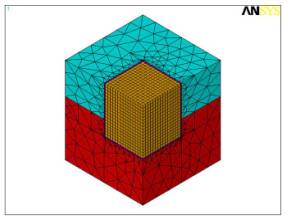
Analysis of Stress Distribution in the Photopolymerization
of Resins and Subsequent Release of Tensions after Hygroscopic Expansion
Replacing traditional mechanical methods of retaining restorative materials
are currently being used conservative methods of adherence. The concept
of large preparations is being abolished and replaced by less invasive
preparation, with the adhesives methods. You can find bonding agents that
adhere to various substrates (dentin, enamel, amalgam, metal and porcelain),
being that the adhesiveness to each is distinct.
When using a resin to fill a preparation, this can be cured or not, and
that healing can be followed by a contraction of the material. The contraction
of a resin is a mechanical property. When applying restrictions on the
movement of the material on contraction and phase change, stresses appear
in it. Those tensions will remain in the material after its polymerization
and may be understood as residual stresses. However, some of these tensions
can be released by hygroscopic expansion that occurs in the resin when
it comes into contact with water.
This study aims to evaluate the residual stresses developed in the polymerization
of photo-activated resins, using different filling techniques, and their
subsequent reduction during hygroscopic expansion.
Aiming to better understand
and model the proposed problem, we decided to fabricate a three dimensional
model of the cavity preparation. Taking
into account the effect of contraction of the resin is less significant
in a region away from the preparation, was adopted by isolating a portion
of biomaterials in the region near the contraction in order to reduce
the size of the model. The figure below illustrates the model with the
three
materials considered: enamel (blue), dentin (red) and resin (orange).
Model

Figure 1
This model has a highly non-linear character. There are two
types of non-linearity: the non-linearity introduced by the steps of
filling (geometric non-linearity) and the non-linearity from the state of
the interface,
ie, if this is breached or not.
TEAM: Estevam Barbosa de las Casas, Rodrigo
Lambert Or éfice, Elissa Talma and João Batista Novaes Júnior.
![]()